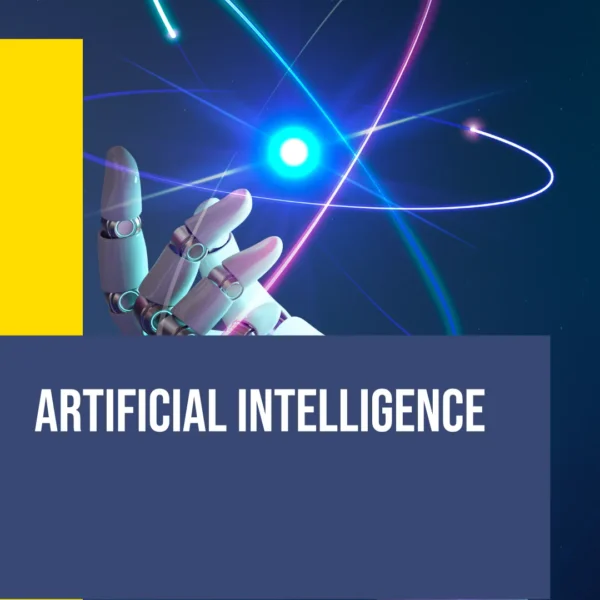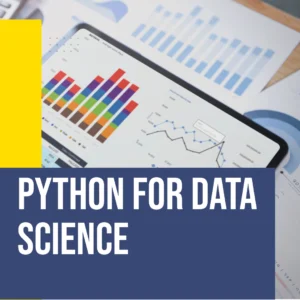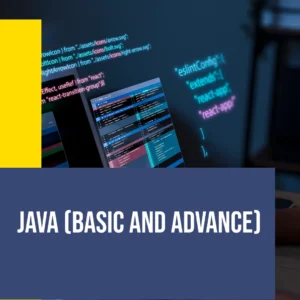Artificial Intelligence
Original price was: ₹19,915.25.₹9,300.00Current price is: ₹9,300.00.
Description
Overview:
This foundational course in Artificial Intelligence covers all the major topics in AI at a higher level. The course is designed to provide a broad overview of AI and its various applications, including machine learning, deep learning, computer vision. Students will learn about the history and definition of AI, and explore the different types of AI systems, including supervised, unsupervised learning algorithms. The course will also cover Artificial Neural Network, Deep Layer Neural Network, and Convolution Neural Network in AI. Finally, the course will conclude with a discussion of the future and trends of AI, including AI ethics and safety. By the end of the course, students will have a solid understanding of AI and its potential impact on society.
Prerequisites:
Familiarity with the basics of Python programming is helpful for this course.
Key Learning Outcomes:
Upon completion of this course, students will be able to:
- Describe the definition and history of AI and identify the different types of AI systems.
- Apply the basics of machine learning, including supervised, unsupervised, and deep learning algorithms, and evaluate models for accuracy.
- Pre-process and represent data for machine learning and deep learning tasks such as supervised, unsupervised, ANN, Deep Layer NN, Convolution NN.
- Pre-process and represent image data for computer vision tasks such as image classification.
- Explain deep learning, including feedforward and convolutional neural networks, and apply deep learning to computer vision, Image classification.
- Analyze the future and trends of AI, including the impact of AI on society and the ethics and safety concerns associated with AI.
- Synthesize the concepts and techniques of AI into a comprehensive understanding of the field.
Target Audience:
This course is ideal for anyone who wishes to learn the details of data science and pursue a career in this growing field of Artificial Intelligence, Machine Learning, Deep Learning, Data Analytics & Data Science.
Test & Evaluation
- During the program, the participants will have to take all assignments given to them for better learning.
- At the end of the program, a final assessment will be conducted.
Certification
- All successful participants will be provided with a certificate of completion.
- Students who do not complete the course / leave it midway will not be awarded any certificate.
Delivery Mode & Duration:
Classroom Training – 120 Hours (60 Hours Classroom sessions + 60 Hours of assignment)
Online Live Mode – 120 Hours (60 Hours Online Live sessions + 60 Hours of assignment)
Module 01 – Introduction of Artificial Intelligence
- Introduction of Artificial Intelligence
- Terminologies of Artificial Intelligence
- Components of Artificial Intelligence – ML & DL
- Difference between AI, ML, Deep Learning
- Introduction to Machine Learning
- History and Evolution of AI
- Find out where AI is applied in Technology and Science.
- Difference between Traditional Programming and ML Programming
Module 02 – Steps of AI/ML Implementations
- Types of Machine Learning
- Labelled Data and Unlabeled Data
- Concept of Supervised Machine Learning
- Concept of Unsupervised Machine Learning
- Steps of Machine Learning
- Concept of Collecting the historic training Data for ML
- Concept of Preprocess data for Machine Learning
- Concept of Train the ML model
- Concept of Test the ML Algorithm
- Concept of using the ML Algorithm
Module 03 – Data Collection for Machine Learning
- Introduction
- Types of Data collection- Offline Data and Online Data
- Practical implementations of Reading the offline dataset using Numpy
- Practical implementations of Reading the online dataset using Numpy
- Practical implementations of Reading the offline dataset using Pandas
- Practical implementations of Reading the online iris dataset using Pandas
Module 04 – Concept of Supervise & Unsupervised Machine Learning
- Introduction
- Types of Machine Learning
- Labelled Data and Unlabeled Data
- Concept of Supervised Machine Learning
- Concept of Unsupervised Machine Learning
- Regression and Classification
- Linear Regression and Logistic Regression
Module 05 – Data Visualization for Machine Learning using Matplotlib
- Introduction
- Concept of Univariate plots
- Univariate Histogram Plots.
- Univariate Density Plots.
- Univariate Box and Whisker Plots.
- Concept of Multivariate plots
- Correlation Matrix Plot
- Scatter Matrix Plot
Module 06 – Practical implementation of Supervised ML Algorithm
- Introduction
- Implementation Foundation of Supervised Machine Learning Algorithms
- Regression and Classification
- Linear Regression and Logistic Regression
- Practical implementations of Supervised ML Algorithms- Linear Regression
- Practical implementations of Supervised ML Algorithms- Logistic Regression
- Concept of Sigmoid Function
- k-NN Algorithm
- Naive Bayes Classifiers
- Decision trees etc.
Module 07 – Practical implementation of Unsupervised Machine Learning
- Introduction
- Concepts and Steps of Unsupervised Machine Learning Algorithm
- Concept of Clustering,
- Practical implementations of Machine Learning Unsupervised Algorithms
- K-Means Clustering.
Module 08 – Prepare Data for ML using Data Transformation Methods
- Introduction
- Need for Data Pre-processing
- Data Transforms Steps
- Types of Data Transformation Methods
- Rescale Data
- Standardize Data
- Normalize Data
- Binarize Data
Module 09 – Feature Selection for Machine Learning
- Introduction
- Feature Selection
- Univariate Feature Selection
- Recursive Feature Elimination
- Principal Component Analysis
- Feature Selection based on Importance.
Module 10 – Data Resampling Methods for Evaluation of ML Models
- Introduction
- Evaluate Machine Learning Algorithms
- Split into Train and Test Sets
- K-fold Cross Validation
- Leave One Out Cross Validation
- Repeated Random Test-Train Splits
- What Techniques to Use When
Module 11 – Machine Learning Algorithm Performance Evaluation Metrics
- Introduction
- Algorithm Evaluation Metrics
- Logistic Regression Algorithm Performance Evaluation Metrics
- Classification Accuracy (Default).
- Logarithmic Loss.
- Area Under ROC Curve (AUC).
- Confusion Matrix.
- Classification Report.
- Linear Regression Algorithm Performance Evaluation Metrics
- Mean Absolute Error.
- Mean Squared Error.
- R2 Error
Module 12 – Spot-Check Machine Learning Algorithms
- Concept of Algorithm Spot-Checking
- Algorithms Overview
- Linear Machine Learning Algorithms Spot-check
- Nonlinear Machine Learning Algorithms Spot-check
Module 13 – Introduction to Deep Learning
- A revolution in Artificial Intelligence
- Limitations of Machine Learning
- What is Deep Learning?
- Advantage of Deep Learning over Machine learning
Module 14 – Introduction to Neural Networks
- How Deep Learning Works?
- Introduction to Neural Networks
- Neural Network Architecture
- The Neuron
- Training a Perceptron
- Concept of Gradient Descent
- Stochastic Gradient Descent (SDG)
- Activation Functions
- Neural Network Layers
Module 15 – Deep dive into ANN with Tensor Flow
- Understand limitations of a Single Perceptron
- Deepening the network
- Tensor Flow code-basics
- Tensor flow data types
- CPU vs GPU vs TPU
- Tensor flow methods
- Overfitting and Regularization
- Debugging Neural Networks
- Visualizing NN using Tensor Flow
- The MNIST Dataset
- Coding MNIST NN
- Linear Regression example revisited.
- Generalization, Overfitting, Under fitting
Module 16 – Computer Vision
- Introduction to image processing and computer vision
- Convolutional features for visual recognition
- Object detection
- Image classification
Module 17 – Introduction of Convolutional Neural Networks (CNN)
- Introduction
- Images and Pixels
- How humans recognize images
- Convolutional Neural Networks
Module 18 – Architecture of Convolutional Neural Networks (CNN)
- ConvNet Architecture
- Strides and Zero Padding
- Max Pooling and ReLU activations
- Dropout
- Coding Deep ConvNets demo
Module 19 – Keras API
- Keras API
- How to compose Models using Keras
- Sequential Composition
- Neural Network Layers with Keras & Tensor Flow
Module 20 – Conclusion and Future of Artificial Intelligence
- Summary of Artificial Intelligence concepts and techniques
- Artificial Intelligence trends and future developments
- Artificial Intelligence and society
- Artificial Intelligence ethics and safety.
You can also give us a call on Mobile +91-9335469335





